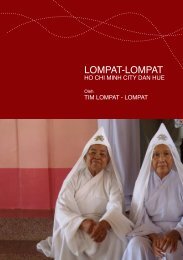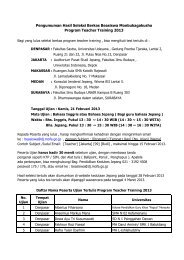9700_y16_sy
9700_y16_sy
9700_y16_sy
Create successful ePaper yourself
Turn your PDF publications into a flip-book with our unique Google optimized e-Paper software.
Cambridge International AS and A Level Biology <strong>9700</strong> <strong>sy</strong>llabus Practical assessment<br />
4.3.1 Mark scheme for Paper 5<br />
Paper 5 is marked using the generic mark scheme shown below. The expectations for each mark category<br />
are listed in the sections that follow.<br />
Skill Total marks Breakdown of marks<br />
Planning 15 marks Defining the problem 5 marks<br />
Methods<br />
10 marks<br />
Analysis, conclusions and evaluation 15 marks Dealing with data 8 marks<br />
Evaluation<br />
Conclusions<br />
4 marks<br />
3 marks<br />
4.3.2 Expectations for each mark category (Paper 5)<br />
Planning<br />
For planning, candidates use a given scenario and background information to identify key variables and<br />
develop a procedure to test a hypothesis or prediction.<br />
These marks are awarded for two strands of skills:<br />
• Defining the problem<br />
• Methods.<br />
Defining the problem<br />
From a given scenario candidates should be able to:<br />
• Express the aim of an experiment or investigation as a prediction or hypothesis, expressed in words or<br />
in the form of a sketch graph showing the expected result. The hypothesis should be:<br />
– a quantitative, testable, falsifiable prediction of the likely outcome<br />
– based on the information given in the question and on their knowledge and understanding of the<br />
topic being considered<br />
• Identify the independent variable in the experiment or investigation as the factor(s) that is manipulated or<br />
changed. An experiment may incorporate changes in two independent variables, for example, the effect<br />
of light intensity on the rate of photo<strong>sy</strong>nthesis at two or more concentrations of carbon dioxide<br />
• Identify the dependent variable as the factor that is measured directly during the experiment or<br />
investigation. The dependent variable may respond to the changes in the independent variable<br />
– in some cases candidates may be required to identify that there is more than one dependent<br />
variable measured in an experiment, e.g. both the carbon dioxide release and oxygen uptake may be<br />
measured in respiration experiments<br />
– For investigations that have a hypothesis or aim stated in terms of a variable that cannot be<br />
measured directly, candidates will be required to identify:<br />
○ a feature of the investigation that can be measured directly, e.g. rate of transpiration<br />
○ a measurable aspect of transpiration that can be used, such as mass loss, distance moved by<br />
water in a capillary in a specified time<br />
Back to contents page<br />
www.cie.org.uk/alevel<br />
65





